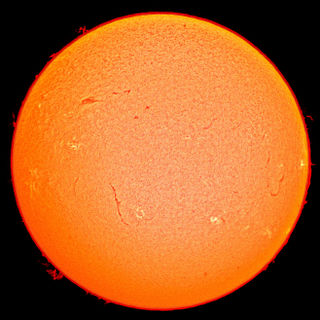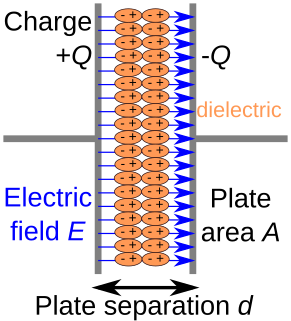| Look up potential or potentially in Wiktionary, the free dictionary. |
Potential generally refers to a currently unrealized ability, in a wide variety of fields from physics to the social sciences.
| Look up potential or potentially in Wiktionary, the free dictionary. |
Potential generally refers to a currently unrealized ability, in a wide variety of fields from physics to the social sciences.
| This disambiguation page lists articles associated with the title Potential. If an internal link led you here, you may wish to change the link to point directly to the intended article. |

In physics, electromagnetic radiation refers to the waves of the electromagnetic field, propagating (radiating) through space, carrying electromagnetic radiant energy. It includes radio waves, microwaves, infrared, (visible) light, ultraviolet, X-rays, and gamma rays.

Electromagnetism is a branch of physics involving the study of the electromagnetic force, a type of physical interaction that occurs between electrically charged particles. The electromagnetic force is carried by electromagnetic fields composed of electric fields and magnetic fields, and it is responsible for electromagnetic radiation such as light. It is one of the four fundamental interactions in nature, together with the strong interaction, the weak interaction, and gravitation. At high energy the weak force and electromagnetic force are unified as a single electroweak force.

In physics, energy is the quantitative property that must be transferred to an object in order to perform work on, or to heat, the object. Energy is a conserved quantity; the law of conservation of energy states that energy can be converted in form, but not created or destroyed. The SI unit of energy is the joule, which is the energy transferred to an object by the work of moving it a distance of 1 metre against a force of 1 newton.

In physics, potential energy is the energy held by an object because of its position relative to other objects, stresses within itself, its electric charge, or other factors.

A dielectric is an electrical insulator that can be polarized by an applied electric field. When a dielectric is placed in an electric field, electric charges do not flow through the material as they do in an electrical conductor but only slightly shift from their average equilibrium positions causing dielectric polarization. Because of dielectric polarization, positive charges are displaced in the direction of the field and negative charges shift in the direction opposite to the field. This creates an internal electric field that reduces the overall field within the dielectric itself. If a dielectric is composed of weakly bonded molecules, those molecules not only become polarized, but also reorient so that their symmetry axes align to the field.
An electric potential is the amount of work needed to move a unit of charge from a reference point to a specific point inside the field without producing an acceleration. Typically, the reference point is the Earth or a point at infinity, although any point can be used.

Electromotive force, is the electrical action produced by a non-electrical source. A device that converts other forms of energy into electrical energy, such as a battery or generator, provides an emf as its output. Sometimes an analogy to water "pressure" is used to describe electromotive force.

The Aharonov–Bohm effect, sometimes called the Ehrenberg–Siday–Aharonov–Bohm effect, is a quantum mechanical phenomenon in which an electrically charged particle is affected by an electromagnetic potential, despite being confined to a region in which both the magnetic field B and electric field E are zero. The underlying mechanism is the coupling of the electromagnetic potential with the complex phase of a charged particle's wave function, and the Aharonov–Bohm effect is accordingly illustrated by interference experiments.

Classical electromagnetism or classical electrodynamics is a branch of theoretical physics that studies the interactions between electric charges and currents using an extension of the classical Newtonian model. The theory provides a description of electromagnetic phenomena whenever the relevant length scales and field strengths are large enough that quantum mechanical effects are negligible. For small distances and low field strengths, such interactions are better described by quantum electrodynamics.

The magnetic moment is the magnetic strength and orientation of a magnet or other object that produces a magnetic field. Examples of objects that have magnetic moments include: loops of electric current, permanent magnets, moving elementary particles, various molecules, and many astronomical objects.
In physics, a unified field theory (UFT) is a type of field theory that allows all that is usually thought of as fundamental forces and elementary particles to be written in terms of a pair of physical and virtual fields. According to the modern discoveries in physics, forces are not transmitted directly between interacting objects, but instead are described and interrupted by intermediary entities called fields.
Polarizability is the ability to form instantaneous dipoles. It is a property of matter. Polarizabilities determine the dynamical response of a bound system to external fields, and provide insight into a molecule's internal structure. In a solid, polarizability is defined as dipole moment per unit volume of the crystal cell.
In quantum mechanics, a parity transformation is the flip in the sign of one spatial coordinate. In three dimensions, it can also refer to the simultaneous flip in the sign of all three spatial coordinates :
The following outline is provided as an overview of and topical guide to energy:
In quantum mechanics, the Pauli equation or Schrödinger–Pauli equation is the formulation of the Schrödinger equation for spin-½ particles, which takes into account the interaction of the particle's spin with an external electromagnetic field. It is the non-relativistic limit of the Dirac equation and can be used where particles are moving at speeds much less than the speed of light, so that relativistic effects can be neglected. It was formulated by Wolfgang Pauli in 1927.
Potential generally refers to a currently unrealized ability. The term is used in a wide variety of fields, from physics to the social sciences to indicate things that are in a state where they are able to change in ways ranging from the simple release of energy by objects to the realization of abilities in people. The philosopher Aristotle incorporated this concept into his theory of potentiality and actuality, a pair of closely connected principles which he used to analyze motion, causality, ethics, and physiology in his Physics, Metaphysics, Nicomachean Ethics and De Anima, which is about the human psyche. That which is potential can theoretically be made actual by taking the right action; for example, a boulder on the edge of a cliff has potential energy that could be actualized by a push forcing it over the edge of the cliff.

In physics, a field is a physical quantity, represented by a number or tensor, that has a value for each point in space-time. For example, on a weather map, the surface temperature is described by assigning a real number to each point on a map; the temperature can be considered at a fixed point in time or over some time interval, to study the dynamics of temperature change. A surface wind map, assigning a vector to each point on a map that describes the wind velocity at that point, would be an example of a 1-dimensional tensor field, i.e. a vector field. Field theories, mathematical descriptions of how field values change in space and time, are ubiquitous in physics. For instance, the electric field is another rank-1 tensor field, and the full description of electrodynamics can be formulated in terms of two interacting vector fields at each point in space-time, or as a single-rank 2-tensor field theory.
Most of the terms listed in Wikipedia glossaries are already defined and explained within Wikipedia itself. However, glossaries like this one are useful for looking up, comparing and reviewing large numbers of terms together. You can help enhance this page by adding new terms or writing definitions for existing ones.
This glossary of physics is a list of definitions of terms and concepts relevant to physics, its sub-disciplines, and related fields, including mechanics, materials science, nuclear physics, particle physics, and thermodynamics.
Electromagnetism is the study of forces between charged particles, electromagnetic fields, electric (scalar) potentials, magnetic vector potentials, the behavior of conductors and insulators in fields, circuits, magnetism, and electromagnetic waves. An understanding of electromagnetism is important for practical applications like electrical engineering and chemistry. In addition, concepts taught in courses on electromagnetism provide a basis for more advanced material in physics, such as quantum field theory and general relativity. This article focuses on a conceptual understanding of the topics rather than the details of the mathematics involved.